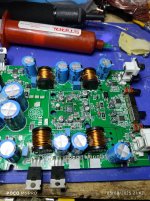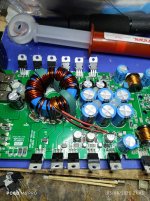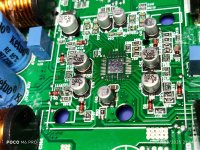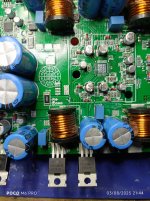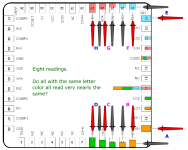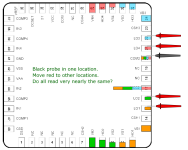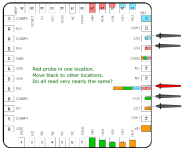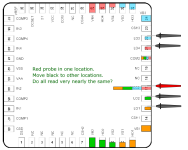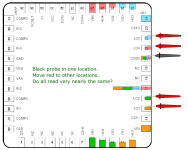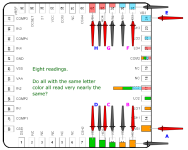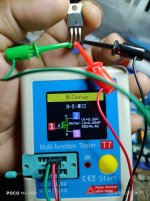Hello,
I've checked all the MOSFETS, inductors, diodes and filter caps and there's no shorts. I've removed the IRS 2093. When I turn the amplifier on, with only channel 2 high and low side transistors in and they're getting hot, I limit my PSU to 1amp hence why I think this hasn't blown up yet I think.
When all channels are populated with MOSFETS only channel 3 MOSFETS get warm, mostly the high side one.
Now with only channel 2 populated the high side is significantly hotter than the low side.
What could be the cause of this?
I've checked all the MOSFETS, inductors, diodes and filter caps and there's no shorts. I've removed the IRS 2093. When I turn the amplifier on, with only channel 2 high and low side transistors in and they're getting hot, I limit my PSU to 1amp hence why I think this hasn't blown up yet I think.
When all channels are populated with MOSFETS only channel 3 MOSFETS get warm, mostly the high side one.
Now with only channel 2 populated the high side is significantly hotter than the low side.
What could be the cause of this?
Attachments
Without the driver IC, there is nothing to keep the outputs from conducting. If you connect a resistor from gate to source on all of the installed output FETs (2093 out of the circuit), they will likely not heat up.
The IC could be defective or you could have a leaky FET.
Install the resistors (try 100k, if you have them). Do they still heat up?
Measure the resistance across the two halves of all 8 of the drive circuits. Do any read low? Do the corresponding drive outputs for all 4 channels read similarly?
Install the resistors (try 100k, if you have them). Do they still heat up?
Measure the resistance across the two halves of all 8 of the drive circuits. Do any read low? Do the corresponding drive outputs for all 4 channels read similarly?
The IC is brand new.
I'm going to have to get those resistors tommorow.
Sorry, I don't understand.
I'm going to have to get those resistors tommorow.
Sorry, I don't understand.
Do you have any high-value resistors?
ICs can be damaged when installing them, generally due to heat, especially if using hot air.
Are the output FETs original?
If not, are they the same exact part number?
What was the amp doing before replacing the IC?
ICs can be damaged when installing them, generally due to heat, especially if using hot air.
Are the output FETs original?
If not, are they the same exact part number?
What was the amp doing before replacing the IC?
I think I have some, I'll check it in the morning. I've been at this all day.
I've de-soldered and soldered a few of these, 380⁰C low air, STIRRI flux and at the most it takes about 25-50 seconds to solder and de-solder the IC.
Yes sir, from factory. I checked all of them they're good, I also checked the caps and the inductors also. The last one you helped me a burned inductor was the fault.
It just turns on and no output, but when I replaced the IC it fully turns on, but drawing 2.8 amps of current, I limit the PS to 3 amps, after a few seconds it hits the 3 amps limit and the voltage drops down to 7 volts, that's when I shut the amp down.
When I touch the FETs the ones on channel 3 are hot especially the high side FET. The surrounding inductor and caps is also warm. At first I thought it was a bad cap or inductor m, so I took them out and checked them and they're okay, for the most part. The caps and the inductor values are pretty low.
The caps are rated at 470 uf 63 volts but when tested with a cheap LCR tester they are ranging in the 420-430 uf. It's the same thing with the inductors, the schematic says 22uh and the meter reads lower than that.
Okay so it turns out the meter is correct, more or less. It reads 0.02mh which converts to 20uh.
I've de-soldered and soldered a few of these, 380⁰C low air, STIRRI flux and at the most it takes about 25-50 seconds to solder and de-solder the IC.
Yes sir, from factory. I checked all of them they're good, I also checked the caps and the inductors also. The last one you helped me a burned inductor was the fault.
It just turns on and no output, but when I replaced the IC it fully turns on, but drawing 2.8 amps of current, I limit the PS to 3 amps, after a few seconds it hits the 3 amps limit and the voltage drops down to 7 volts, that's when I shut the amp down.
When I touch the FETs the ones on channel 3 are hot especially the high side FET. The surrounding inductor and caps is also warm. At first I thought it was a bad cap or inductor m, so I took them out and checked them and they're okay, for the most part. The caps and the inductor values are pretty low.
The caps are rated at 470 uf 63 volts but when tested with a cheap LCR tester they are ranging in the 420-430 uf. It's the same thing with the inductors, the schematic says 22uh and the meter reads lower than that.
Okay so it turns out the meter is correct, more or less. It reads 0.02mh which converts to 20uh.
Good day Mr Babin, so I found 2 47K ohm resistors placed them gate to source on one channel, the FETs don't heat up anymore.
I'm trying to figure out what you mean with the last paragraph.The IC could be defective or you could have a leaky FET.
Install the resistors (try 100k, if you have them). Do they still heat up?
Measure the resistance across the two halves of all 8 of the drive circuits. Do any read low? Do the corresponding drive outputs for all 4 channels read similarly?
I'll put together a graphic but it will have wait until I finish something else. About an hour. Until them, download and look over the pin configuration for the 2093.
No problem sir.
I have the PDF of the chip and a schematic of the output section of this amplifier.
I have the PDF of the chip and a schematic of the output section of this amplifier.
You don't need to post readings unless some of the ones you're comparing read significantly different than the others in the images. Check the original and the one you used as a replacement but then removed.
Attachments
Out is better. It can be done when the IC is installed but results can be inconclusive.
You can check the pads on the board to see if you read something different there. You will need to remove the pulldown resistors that you installed. You can desolder only one of the leads to make them easier to reconnect, in case that's needed.
You can check the pads on the board to see if you read something different there. You will need to remove the pulldown resistors that you installed. You can desolder only one of the leads to make them easier to reconnect, in case that's needed.
Meter on ohms?
If there is infinite resistance, that's better than low resistance.
megaohms is typically good.
These aren't absolutely definitive but typically mean that the IC is Ok. Generally, when a channel fails, there are shorted internal drivers.
Did you buy the FETs from a reputable distributor?
When it was playing but drawing too much current, did you try moving the inductors to see if any were intermittent?
If there is infinite resistance, that's better than low resistance.
megaohms is typically good.
These aren't absolutely definitive but typically mean that the IC is Ok. Generally, when a channel fails, there are shorted internal drivers.
Did you buy the FETs from a reputable distributor?
When it was playing but drawing too much current, did you try moving the inductors to see if any were intermittent?
Yes sir, meter in ohms. 1.5Mohms, lowest, 7+Mohms on the highest reading.
No infinite reading, just no reading.
Oh I see, so it seems that both ICs are good.
The FETs are original factory FETs.
It was playing but it was fully turned on and then after a few seconds it would start pulling excess current.
All the FETs measure more or less the same.
No infinite reading, just no reading.
Oh I see, so it seems that both ICs are good.
The FETs are original factory FETs.
It was playing but it was fully turned on and then after a few seconds it would start pulling excess current.
All the FETs measure more or less the same.
Attachments
If the meter is on ohms and the reading doesn't change with probing any point, it's infinite resistance (infinite resistance as far as the meter is concerned).
- Home
- General Interest
- Car Audio
- Taramps DS 1200X4 output transistors getting hot and amplifier pulling excess current
